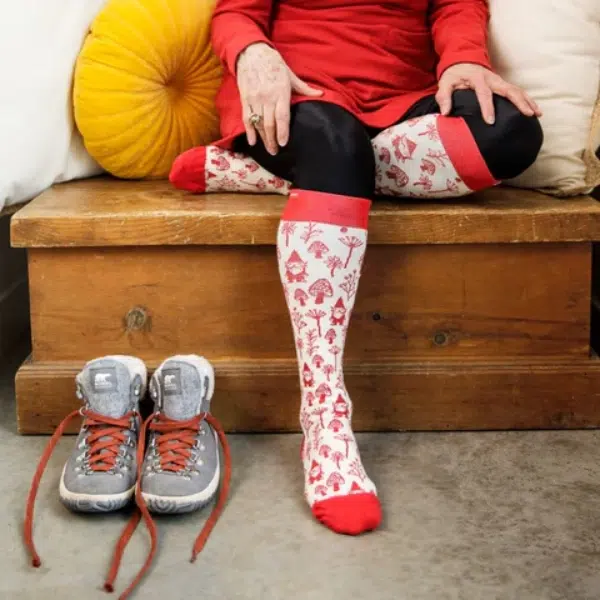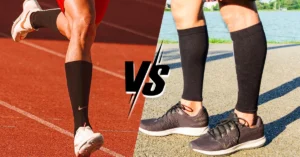Compression socks are professional hosiery designed specifically to enhance several key health factors. They improve blood circulation and venous return, reduce blood pooling and stasis, and enhance lymphatic drainage through the legs. Additionally, they are effective in preventing edema.
Enhancement of these components is a crucial requirement in older adults, as worsening of these conditions can sometimes be lethal for them.
In addition, elderly people face several challenges in their mobility patterns, which can be greatly influenced by wearing compression socks with proper guidelines.

Source:https://www.chestnutsquare.info/the-health-benefits-of-wearing-compression-socks
Therefore, compression socks are an essential asset to older people for their better overall health. However, as an older adult considering compression socks, it is always recommended to be aware of specific considerations. Before opting for compression socks, ensure you understand these important factors.
For instance, several crucial considerations should be made before introducing compression socks to older adults. These include consulting a healthcare provider and ensuring the socks are properly sized and fitting the fabric. Additionally, it’s important to keep track of the wearing schedules and durations. Moreover, one should be cautious of pre-existing medical conditions like diabetes mellitus or peripheral arterial disease (PAD).
So, let’s uncover different aspects of compression socks for older people and dive into the debate!
How do Compression Socks Contribute to the Overall Health of the Elderly People?

Source:https://www.louisianaheart.org/blog/what-we-want-you-to-know-about-varicose-veins-after-60
As a person’s age advances, he gets prone to several health problems, where mobility and cardiac health usually lead the rest. He encounters a range of hurdles that significantly limit his range of motion.
The elderly commonly face challenges such as sarcopenia, joint pain, and arthritis. They also deal with reduced fatigue tolerance and decreased cardiovascular efficiency. Aging often leads to arterial stiffness due to reduced vascular elasticity. Additionally, dysfunctional venous valves or weakened vein walls impair the return of blood from the legs to the heart, leading to decreased tissue oxygenation.
However, compression socks and gear are essential in managing these conditions with their specialized properties. Here, we will discover each problem individually and the improvement associated with compression socks right after them.

Source:https://vimvigr.com/blogs/our-blog/the-benefits-of-compression-socks-for-seniors
1) Sarcopenia
Advancing age causes the loss of muscle mass and strength, known as sarcopenia. As people age, they experience significant muscle wasting, particularly after their 50s or 60s, which leads to a lack of endurance and strength, pondering with their everyday chores.
Effect of Compression Socks on Sarcopenia
Compression socks do not directly influence sarcopenia, nor do they function by increasing muscle mass. However, compression socks can significantly improve muscle strength through certain phenomena like improving blood circulation and improving venous return through the legs.
This way, compression gear can reduce the risks of strength and endurance loss by enhancing mobility in older adults.
2) Joint Pain, Arthritis, and Stiffness
Aging is known to significantly cause degenerative changes, such as the deterioration of joint cartilage and the reduction of synovial fluid within the joints. It leads to conditions like joint stiffness or arthritis, which significantly impacts the mobility of the senescent.
The most commonly affected areas in osteoarthritis among adults are the knees and ankles.
Effect of Compression Socks on Joint Stiffness and Arthritis
Compression socks are instrumental in reducing joint stiffness and arthritis by providing credible support to the joints. They help to alleviate pain associated with joint arthritis, providing comfort during prolonged periods of sitting or standing.
Moreover, compression socks also improve circulation, helping to alleviate joint stiffness related to degenerative changes within the joints.

Source:https://www.afm.org.my/2021/11/11/the-hidden-meaning-of-joint-pain-and-stiffness-in-the-morning/
3) Reduced Cardiovascular Efficiency
With the advancement of age, there is a significant weakening of essential organs, including the heart and the lungs, which play a crucial role in cardiovascular efficiency.
Reduced cardiovascular efficiency is directly linked to increased fatigue and a lack of endurance and strength.
Effect of Compression Socks on Reduced Cardiovascular Efficiency
As previously mentioned, compression socks enhance circulation by improving venous return from the legs to the heart and preventing blood stasis. These benefits are crucial for boosting strength and reducing fatigue. Thus, it helps the elderly stay more active and feel more nurtured.
4) Increased Risks of Blood Clots, Venous Insufficiency, and Thrombotic vascular diseases
Advancing age affects the strength of vascular walls, especially impacting the one-way venous valves. This weakening significantly increases the risks of blood clots and venous insufficiency, with the legs being particularly vulnerable.
An increase in venous insufficiency can lead to conditions such as blood pooling or blood stasis. These issues directly hinder an individual’s ability to remain active. On the other hand, increased risks of blood clots can lead to conditions such as deep venous thrombosis (DVT). This condition further complicates the venous return to the heart.
Effect of Compression Socks on Risks of Blood Clots and Venous Insufficiency
Compression socks are specifically effective and of vital importance in minimizing the risks of blood clots by reducing blood pooling and stasis within the legs.
Less mobile adults are more prone to thrombotic vascular diseases. Wearing compression gear can greatly influence their health as it is known to improve blood circulation throughout the body.

Source:https://www.medicalnewstoday.com/articles/153704#definition
5) Reduced Oxygenation of the Tissues
Slower circulation is directly linked to advancing age, leading to reduced oxygenation of the tissues. Since blood is the only source of nutrients and oxygen for the tissues, this slowdown can have significant health implications.
This reduced oxygenation can cause several problems, like reduced stamina, increased fatigue, and poor activity status.
Effect of Compression Socks on Inefficient Oxygenation of the Tissues
Ince compression socks enhance blood circulation. They can greatly improve oxygen supply, countering the effects of inefficient oxygenation.
6) Swelling and Edema
Aged people are more prone to swelling and edema, particularly in their feet and legs, due to the pressure of gravity. This swelling and edema cause significant pain and discomfort within the legs, making it difficult for the senescent to withstand their everyday chores.
Effect of Compression Socks on Swelling and Edema

Source:https://compvasccare.com/why-you-should-not-ignore-swollen-legs/
Compression socks provide graduated compression within the legs, which plays a great role in improving swelling and edema.
Not only this, but improved swelling will also lead to reduced pain and discomfort, which will help the aged to stay active and tireless during their everyday chores.
Key Considerations that Elderly Should Take Care of While Wearing Compression Socks
Although compression socks are of great significance for the senescent because of their vast range of benefits and advances in overall health profile, one should still take care of several key considerations while opting for compression socks as an aged person.
Following, we have listed all the necessary considerations before looking to wear compression socks as an elderly person:
- Always consult your healthcare professional before wearing compression socks. Your doctor will recommend the appropriate compression level and proper fitting size according to your needs. He will also take care of whether compression socks are safe for you or not.
- Ensure accurate sizing and ideal material for effective safety and optimal use.
- Wearing compression socks can be challenging for the elderly; using tools like metal frames or donners can make the process easier.
- Always check up on your skin while wearing compression socks as the skin of elders is significantly fragile and prone to several skin conditions like dermatitis, vasculitis, redness, sores, or bruisings.
- Always be cautious with already existing medical conditions like diabetes mellitus or peripheral arterial disease, as compression socks are not suitable to be worn with such health conditions.
- Take care of regular follow-ups with your healthcare provider for the most effective results.

Source:https://www.touchinghearts.com/nyc/blog/the-benefits-of-compression-socks-for-seniors/
FAQs
Q1. Can elderly people wear compression socks?
Yes! Elderly people can wear compression socks as recommended by their healthcare providers.
Q2. What is the best alternative to compression socks for the elderly?
The best alternatives to compression socks for the elderly are leg wraps or bandages, compression tights, exercise and adequate movements of the legs, diet, proper hydration, sitting with elevated legs, orthotic soles, anti-fatigue mats, and regular physiotherapy.

Source:https://eldergym.com/leg-workout/
Q3. Who cannot wear compression socks?
Patients with peripheral arterial disease or diabetes mellitus are not recommended to wear compression socks.
Q4. What is the major drawback of compression stockings?
Although compression socks have several potential benefits, the major drawback associated with their frequent use is skin problems like sores, bruises, redness, and itching.
Q5. Can I sleep with compression socks?
There is no profit in wearing compression socks while sleeping, so it is always best to put them off while in bed.

Source:https://www.griswoldcare.com/blog/sleep-in-the-elderly-what-is-normal/
Q6. How long should the elderly wear compression socks?
The elderly should wear compression socks according to the timings and durations prescribed by their healthcare professionals. Never wear them for too long as this can cause severe distress.
The Final Verdict
Advancing age greatly hinders the mobility and overall health of individuals. However, compression socks consistently provide professional comfort to all those aging problems through specialized graduated pressure and support.
Compression socks significantly help with certain age-advancing conditions like support and comfort during sarcopenia, enhanced blood circulation and venous return for enhanced bodily activities and efficient cardiovascular health, better oxygenation of the tissues, and support during joint stiffness and arthritis because of degenerative changes in advancing ages.
However, always be mindful of certain considerations, as wearing compression socks as a senescent might not always be appropriate. So it is always best to consult your healthcare provider before making decisions.
We hope this information has covered everything for you. Stay happy and healthy!



